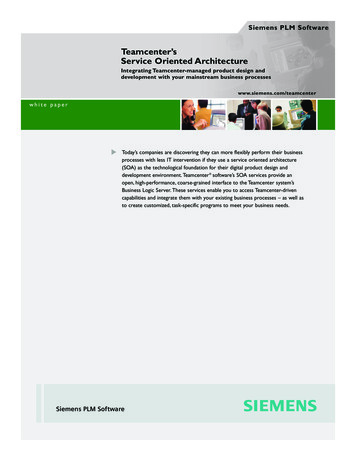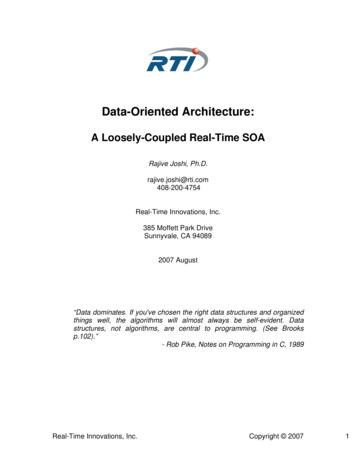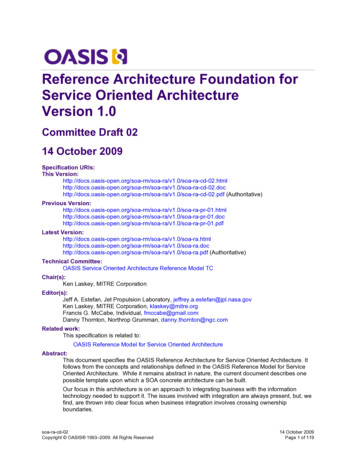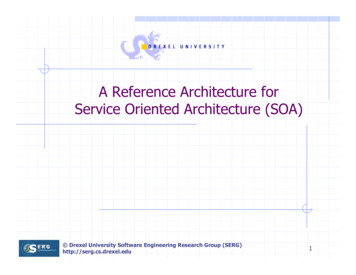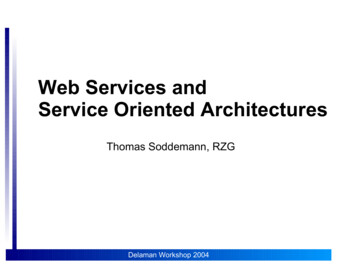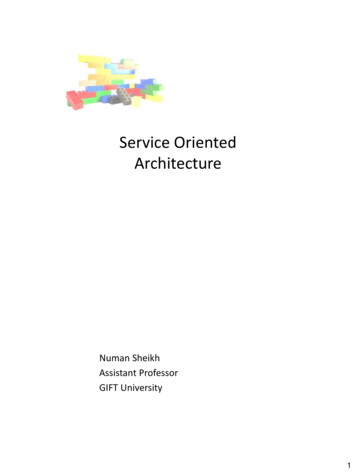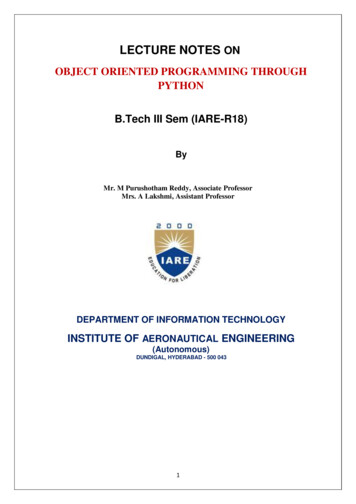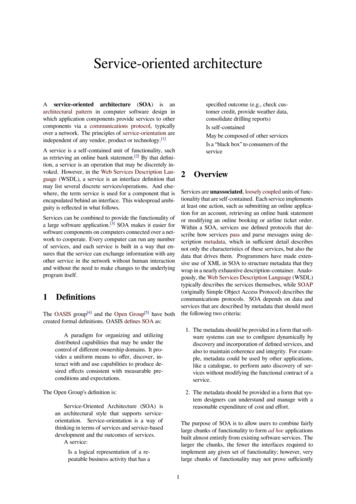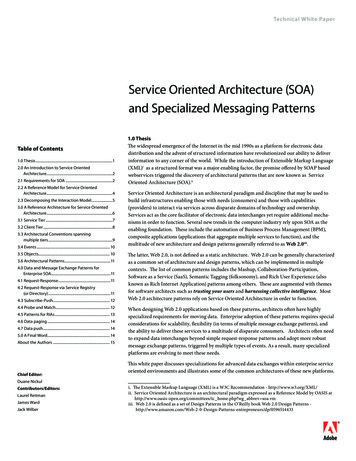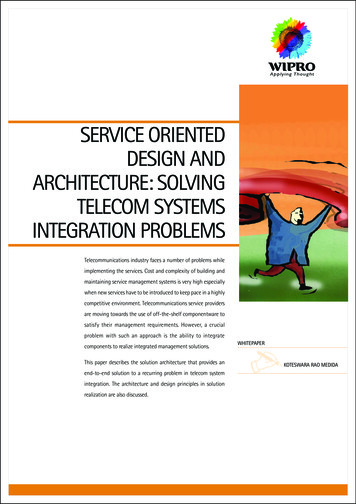
Transcription
SERVICE ORIENTEDDESIGN ANDARCHITECTURE: SOLVINGTELECOM SYSTEMSINTEGRATION PROBLEMSTelecommunications industry faces a number of problems whileimplementing the services. Cost and complexity of building andmaintaining service management systems is very high especiallywhen new services have to be introduced to keep pace in a highlycompetitive environment. Telecommunications service providersare moving towards the use of off-the-shelf componentware tosatisfy their management requirements. However, a crucialproblem with such an approach is the ability to integratecomponents to realize integrated management solutions.This paper describes the solution architecture that provides anend-to-end solution to a recurring problem in telecom systemintegration. The architecture and design principles in solutionrealization are also discussed.WHITEPAPERKOTESWARA RAO MEDIDA
Interaction of RFID Technology and Public PolicyTable of ContentsINTRODUCTION . 3BUSINESS FACTORS DRIVING COMPONENT BASED ARCHITECTURES . 3ARCHITECTURE AND DESIGN PRINCIPLES TO MEETCHANGING REQUIREMENTS . 4INTEGRATION STRATEGIES . 5SOLUTION ARCHITECTURE . 12SOLUTION REALIZATION . 12CONCLUSION . 15REFERENCES . 15ABOUT THE AUTHOR . 15ABOUT WIPRO TECHNOLOGIES . 16Page: Table of Contents
Service Oriented Design and Architecture: Solving Telecom Systems Integration ProblemsINTRODUCTIONVarious issues arise with service line architecture involving integration of products with customized solutions. For a smoothapplication integration to support telecom management business processes one requires a fair understanding of architecturalprinciples, solution architecture, and solution realization. Component integration technologies are expected to be the key tothe development of future operational support systems. The state of the relevant component integration technologies isreviewed in the context of these requirements. This paper draws some conclusions on the relative merits of the differenttypes of integration methodologies and makes some suggestions for further work.BUSINESS FACTORS DRIVING COMPONENT BASED ARCHITECTURESThe liberalization of telecom markets across the world has exposed service providers to a high level of competition. Thisrequires them to reduce costs, improve customer service and rapidly introduce new services. One important way in whichthese pressures can be addressed is through improved integration of the many software systems operated by a serviceprovider. This includes amongst others, the integration of different operation support systems. Component based reuse isseen as an increasingly important software development aid, both within the telecom industry and in the wider IT community.Building systems from components that interact through well defined interfaces offer a route for reusing software acrossprojects within a telecom system developer and to integrate commodity third party software into the system. Both of theseoffer development cost savings and improvements in reliability and maintainability. Emerging standards such as EnterpriseJavaBeans and CORBA Components are encouraging the development of platforms that directly support component integration.This is prompting the telecom industry to move towards the widespread adoption of component-based architecture anddesign.Certain business factors drive requirements for revolutionary integration. For telecommunications service providers, theseinclude reductions in Total Cost of Ownership (TCO) and time-to-market new services, both of which provide a competitiveadvantage through improved cash flows.Factors that influence TCO fall in two categories: 1) cost of building the solution and 2) cost of operations and maintenance.The first cost is tied to the time and effort required to build, test, and configure the solution, which is influenced by solutionmodeling approaches and the availability of appropriate tools.Many factors influence operations and maintenance costs. These include the effort to integrate new applications, the effortto implement changes in process definition and messaging requirements, the ease of configuring, monitoring andtroubleshooting, and so on. The solution should also be future-proof relatively insensitive to technology changes. Choosingthe right solution architecture can significantly reduce both these costs. The history of information technology points tomore sophisticated solutions using higher levels of abstraction. Higher levels of abstraction lets you focus on the essentialfeatures of the problem. One way to do this is to use the right models. The remainder of this article presents a solutionarchitecture that addresses the business imperatives mentioned above. The solution described here is based on the NextGeneration Operations Systems and Software (NGOSS) initiative from the Tele Management Forum (TMF) [3]. Another initiativethat addresses the Implementation issues is OSS/J [4] initiative from SUN. Wipro TechnologiesPage: 03 of 16
Service Oriented Design and Architecture: Solving Telecom Systems Integration ProblemsARCHITECTURE AND DESIGN PRINCIPLES TO MEET CHANGING REQUIREMENTSMost of the legacy software systems are tightly coupled and are finding it difficult to keep pace with the rapidly changingbusiness scenario. Early software systems were relatively static and any change required in the functionality would demandextensive editing of the source code. In contemporary systems, the changes are anticipated early and the variants in architectureand design are incorporated in early stages. These systems are more dynamic. Variability mechanisms have been present inproduct line architectures [1]. They are equally applicable in service line architecture also. Variability can be handled atdifferent levels of abstraction. Variation points can be introduced at architecture, detailed design and implementation phase.The intention of having a provision for a variation point in a system is to be able to insert a variant at a later stage.In component-based design, the component can be replaced easily without changing the calling component. The sourcecode dependencies between components are minimized. With dynamic binding, the system will be able to use new componentsat run-time; the system need not be shut down.A design that doesn’t take change into account is likely to face the risk of redesign within a short span of time whereas asystem with a design that is robust to changes lasts long. The variable elements in a design need to be identified andaddressed early to make the system robust to changes.Some of the common causes of designing for change and how design patterns address them are [2]:1. Creating an Object by Specifying a Class ExplicitlySpecifying a class name when creating an object commits a designer to a particular implementation instead of a particularinterface. This commitment can complicate future changes. To avoid it, create objects indirectly.Design patterns: Abstract Factory, Factory Method, Prototype2. Dependence on Specific OperationsWhen a particular operation is specified, there is one way of satisfying a request. By avoiding hard-coded requests, it is easierto change the way a request gets satisfied both at compile-time and at run-time.Design patterns: Chain of Responsibility, Command3. Dependence on Hardware and Software PlatformExternal operating system interfaces and application programming interfaces (APIs) are different on different hardware andsoftware platforms. Software that depends on a particular platform will be harder to port to other platforms. It may even bedifficult to keep it up-to-date on its native platform. It’s important therefore to design your system to limit its platformdependencies.Design patterns: Abstract Factory, Bridge4. Dependence on Object Representations or ImplementationsClients that know how an object is represented, stored, located, or implemented might need to be changed when the objectchanges. Hiding this information from clients keeps changes from cascading.Design patterns: Abstract Factory, Bridge, Memento, Proxy5. Algorithmic DependenciesAlgorithms are often extended, optimized, and replaced during development and reused. Objects that depend on an. algorithmwill have to change when the algorithm changes. Therefore algorithms that are likely to change should be isolated.Design patterns: Builder, Iterator, Strategy, Template Method, and Visitor Wipro TechnologiesPage: 04 of 16
Service Oriented Design and Architecture: Solving Telecom Systems Integration Problems6. Tight CouplingClasses that are tightly coupled are hard to reuse in isolation, since they depend on each other. Tight coupling leads tomonolithic systems, where you can’t change or remove a class without understanding and changing many other classes. Thesystem becomes a dense mass that’s hard to learn, port, and maintain.Loose coupling increases the probability that a class can be reused by itself and that a system can be learned, ported,modified, and extended more easily. Design patterns use techniques such as abstract coupling and layering to promoteloosely coupled systems.Design patterns: Abstract Factory, Bridge, Chain of Responsibility, Command, Facade, Mediator, and Observer7. Extending Functionality by Sub ClassingCustomizing an object by sub classing often isn’t easy. Every new class has a fixed implementation overhead (initialization,finalization, etc.). Defining a subclass also requires an in-depth understanding of the parent class. For example, overridingone operation might require overriding another. An overridden operation might be required to call an inherited operation.And sub classing can lead to an explosion of classes, because you might have to introduce many new subclasses for even asimple extension.Object composition in general and delegation in particular provides flexible alternatives to inheritance for combining behavior.New functionality can be added to an application by composing existing objects in new ways rather than by defining newsubclasses of existing classes. On the other hand, heavy use of object composition can make designs harder to understand.Many design patterns produce designs in which you can introduce customized functionality just by defining one sub classand composing its instances with existing ones.INTEGRATION STRATEGIESFor telecommunications companies, quickly deploying and offering new services is imperative for competitive advantage.Systems that incorporate this ability have stringent demands in scalability, reliability, and real-time interaction with networkelements. For example, creating, deploying, and offering a new service requires complex interactions between several disparatesystems, some of which may be legacy systems (Refer Figure 1). The problem is how to achieve this integration in a speedy,cost-effective and flexible manner. It’s important to minimize costs for building and maintaining integration solutions. Thereare various approaches of solving integration problems and the architectures vary. The example given regardingtelecommunications applies in any domain. The focus here is on architectural issues - not implementation.Sales &MarketingActivationted TootomalsAuBNew tomer CareD ia g n o sticNetworkInterconnectionFigure 1 - Application Portfolio for New Service Offering Wipro TechnologiesPage: 05 of 16
Service Oriented Design and Architecture: Solving Telecom Systems Integration ProblemsPoint-to-Point IntegrationIn point-to-point integration, communication channels are developed between each pair of applications (Refer Figure 2).Such a solution practically not possible as the number of interfaces required grows exponentially. With n applications, n(n-1) interfaces may be required since each application may need an interface with very other application. In practice,however, each application will, on aver-age, requires communication with 30 percent of the other applications. So, witheight applications, adding a ninth will require the development of 8*0.3*2 or about five extra interfaces. The impact of minorchanges in communication requirements and that of adding a new application is significant while maintenance is clearly ing &InvoicingNetworkOperationsOrderManagementFigure 2 - Point-to-Point Integration Wipro TechnologiesPage: 06 of 16
Service Oriented Design and Architecture: Solving Telecom Systems Integration ProblemsMiddleware - Message Oriented IntegrationPoint-to-point integration exponentially increases the number of interfaces. This can be reduced to a linear increase throughthe use of middleware - message-oriented or based on the Common Object Request Broker Architecture or CORBA (Figure 3illustrates this essagingFaultManagementMessage agementFigure 3 - Integration Using Message BusThe solution requires interfacing each application to the message bus through an adapter. Each application has only oneprogrammatic interface, the message bus. Applications communicate by publishing a message to the bus, which delivers themessage to those who subscribe. Subscription topics or queues let subscribers receive only messages they’re interested in.There are variations on this approach; but the concept is the same. Middleware products may also provide value-addedservices such as guaranteed delivery, certified delivery, transactional messaging, message transformation (using brokers), andso on. However, this solution may not be logically much different from a point-to-point solution if every application needsa different messaging interface with every other application. Even though there’s only one programmatic interface throughthe adapter, that interface consists of several logical messaging interfaces, depending on how many different message typesthe adapter needs to process. This represents a significant improvement over the point-to-point solution, but there areseveral important issues:What’s the format in which data is interchanged?How does the application interpret a message it receives?What’s the impact of adding a new application?What’s the impact of changing a message definition? Wipro TechnologiesPage: 07 of 16
Service Oriented Design and Architecture: Solving Telecom Systems Integration ProblemsThis solution depends on pre-defined data structures. The adapter for each application is programmed so it can handle onlydata structures defined at build time. As for the data interchange format, XML [4] is becoming popular because it’s “selfdescribing.” XML is superior to proprietary formats, but it’s not a panacea since both sender and receiver must share acommon vocabulary. Without a common vocabulary, the receiver won’t know how to interpret the data. If a messagerepresents an order, both the sender and receiver must agree that the data encapsulated in an ORDNO tag represents anorder number. Changes in message definitions will require adapters to be re-coded, with consequent maintenance problems.Another, more serious problem is that the process flow is embedded in the application or adapter logic. Consider Figure 3, thelogic regarding what to do next is generally coded into the adapter for a particular system. It’s practically impossible tovisualize the process flow at a high level of abstraction. Changes in the flow will require changes in application logic.(Actually, even though the application data is loosely coupled, the application processes are tightly coupled.) The solution isto externalize the process flow and have it driven by a process engine.Process Engine Based IntegrationIn this approach, a graphical build-time tool typically defines the process flow. This process definition is then exported intosome standard format and loaded into the process engine’s run-time ultManagementMessage agementFigure 4 - Integration Using External Process Engine Wipro TechnologiesPage: 08 of 16
Service Oriented Design and Architecture: Solving Telecom Systems Integration ProblemsThe benefits include a better understanding of process flow; hence a better design of messaging requirements. Easiermaintenance and easier accommodation of changes in process flow are the other advantages. Higher scalability meansmultiple process engines, and it can support an increasing load.Although this approach provides significant advantages, there’s still considerable coding that must occur when, for example,a new application is introduced. And a number of problems remain: changes in the process flow will require re-coding theprocess engine adapter, messages are determined statically at build-time and changes in message definitions will still requirerecoding the adapters. Introducing new applications require a significant amount of configuration and coding. Also, thesolution isn’t a plug-and-play operation.Revolutionary IntegrationApplication integration has been following an evolutionary approach. Now it’s time for a revolutionary approach for integration.Table1 shows key architectural principles of revolutionary integration and their benefits. Although these principles primarilytarget telecommunications OSS, they’re generic enough to apply in any problem domain.Commercial Off-the-Shelf (COTS) is a well-established industry initiative. The Software Engineering Institute (SEI) has a welldocumented COTS-based system initiative. A contract describes services offered by a COTS component. The WorkflowManagement Coalition is actively involved in standards for process definition.Examples of policies are security policies, which specify authentication, access control, and encryption requirements betweencomponents and contract trading policies, which are used to select one from a set of applicable contracts. Work that hasbeen done in other areas, such as policy based network management, can provide important inputs here.The registry will typically contain information about process definitions, data models, contracts, and the status of COTScomponents and adapters. Wipro TechnologiesPage: 09 of 16
Service Oriented Design and Architecture: Solving Telecom Systems Integration ProblemsPrincipleBenefitsUse Commercial Off-the-Shelf Rapid construction of(COTS) components to build integration solutionssystemsIssues Selection of appropriateCOTS systems Mismatch betweensystem requirementsand COTS capabilitiesUse of contracts to invokeCOTS functionality Plug-and-play operation Industry wide agreement More robust systemson contract specificationsthrough contract enforcement Vendor supportReduced testing effortfor standardizedcontractsUse of an external processengine Minimal impact of definition Standard process Easier maintainabilitydefinition language Better visualization Process engineof process changes in processpluggabilityUse of shared framework Better maintainability of theservicessuchas solution due to separationcommunication, security, and of concernsbusiness process management Use of standardized interfaces or contracts toaccess these servicesUse of policies to regulate Superior system Standardization ofsystem, behavior use of a administration due topolicy scope, definition,registry to store build-time and declarative approachand usagerun-time information Superior control, Registry schemamonitoring, anddefinition andtroubleshootinginteroperability Rapid configuration/re-con-figuration of solutionsTable 1 — Revolutionary Integration Architectural Principles Wipro TechnologiesPage: 10 of 16
Service Oriented Design and Architecture: Solving Telecom Systems Integration ProblemsIn Revolutionary integration solution, each COTS component provides a service. Furthermore, COTS components can beclassified as either Business Service Components (BSCs) or as Framework Service Components (FSCs). BSCs offer services suchas order processing, provisioning, and billing. FSCs offer services such as communications, workflow management, policymanagement, and security. Each COTS component supports a well-defined interface called a contract. The contract specifiesa set of services offered by a particular component.The definition of each service includes name of the service, parameters required providing it defined in terms of objects in theShared Data Model (SDM), conditions under which the service will be provided (pre-conditions), conditions that may ariseafter the service is provided (post-conditions), problems that could arise when the service is provided (exceptions), and thetype of communication that should be used to invoke the service (message, CORBA, etc.).InventoryCircuitCustomerPriceENDThe SDM is formed bycombining ports of objects frommultiple CDMsLocal CarrierFigure 5 — SDMs and CDMs for ProvisioningPre-conditions, post-conditions, and exceptions are an important part of a contract specification and go a long way towardbuilding robust systems. The input and output parameters of contracts are specified in terms of objects defined in an SDM.An SDM is a model of data that needs to be shared between COTS components. It represents a common, external representationof information that needs to be exchanged between COTS components. This means that, when a COTS component wants tocommunicate with another, it will convert it into SDM objects. Each COTS component has its own data model. The portion ofthis data model that needs to be shared with at least one other application will be called a COTS Data Model (CDM). The SDM,therefore, represents the union of all the CDMs. Figure 5 illustrates this. Wipro TechnologiesPage: 11 of 16
Service Oriented Design and Architecture: Solving Telecom Systems Integration ProblemsSOLUTION ARCHITECTUREFigure 6 shows a representative architecture for Revolutionary integration solutions. Two important features of this solutionare the API and the environment manager. This solution requires deploying a special type of API that will: Choose the appropriate type of communication service — message bus, CORBA, Remote Method Invocation(RMI), etc. Translate between COTS-specific interactions and contract invocations Enforce permissions for contract invocations Enforce security policies Trade contracts using policiesThe environment manager will be used to: Configure the environment View the status of process instances, API, components etc. View alerts caused by abnormal situationsSOLUTION REALIZATIONThe architectural principles described earlier are essentially technology-neutral. Realizing these principles will require mappingthem to technology-specific implementations, which requires making choices on platforms, standards, and programminglanguages. Technology specific implementations are beyond the scope of this article, but there’s a good likelihood that manyof the following technologies will be used to implement revolutionary integration solutions: Java 2 Enterprise Edition (J2EE) (OSS/J APIs)[6] XML(OSS/J APIs) Lightweight Directory Access Protocol (LDAP) .NET CORBA Message-Oriented Middleware (MOM) Application servers Web services Wipro TechnologiesPage: 12 of 16
Service Oriented Design and Architecture: Solving Telecom Systems Integration ProblemsThe revolutionary integration solution will typically operate as follows:Each COTS component plugs into the environment, indicating its willing-ness to offer a set of services as defined by contracts.Business ServiceComponentsProcessEngineCOTS SpecificInstructionsAPIAPIAgreementsShared Framework Services(Communication, Security, Process provided by Framework ManagerAPIRegistryAgreementsFigure 6 - Revolutionary Integration ArchitectureThe environment registers the component. It also maintains information about all components and the services they offer.Components that require services can import relevant contracts from the environment. In case more than one provider ofthe service exists, a component can choose the one best suited to its needs through a trading service provided by theenvironment.Normally, the process engine invokes services on BSCs. To avoid tight coupling, a BSC should not directly invoke another BSC.However, it may invoke an FSC.When a component needs a service, it sends a request to the API, which is responsible for invoking the service provider andreturning the results to the requester.An SDM, accessible by all components, defines objects exchanged between components. The adapter translates betweendata representations in the SDM and its own private data model or the CDM. This translation is facilitated through map-pingsbetween the SDM and CDM. Wipro TechnologiesPage: 13 of 16
Service Oriented Design and Architecture: Solving Telecom Systems Integration ProblemsThe environment is also responsible for enforcing policies (such as security policies) that govern the interactions betweencomponents.Integration ApproachIntegrationApproachSalient Difficult to maintainMessage orientedMessaging middlewareNo separation ofbusiness logic andprocess logicProcess engineExternal process engineNo well-definedinteraction semanticsRevolutionary COTS components Contract-definedInterfaces Shared data model Shared frameworkservices Policy Driven API support Overcomes previouslimitations Needs to maturesolution migrationTable 2 - Summary of different integration approaches Wipro TechnologiesPage: 14 of 16
Service Oriented Design and Architecture: Solving Telecom Systems Integration ProblemsCONCLUSIONThis article discussed the issues in service-oriented design and architecture with special emphasis on the telecommunicationsindustry. The approaches were classified into four generations, each representing an increasing level of sophistication. Thebenefits, architecture, and issues pertaining to revolutionary integration were discussed. Also, it summarizes the features andlimitations of the various integration approaches.REFERENCES[1] ‘On the notion of variability in software product lines’, Proceedings of the IEEE conference on software architectureby J.V Gurp, J.bosch and M. Svalmberg, (WICSA 01), 2001[2] ‘Design Patterns‘, by E.Gamma, Rhelm, R.Johnson and J.Vlissides, Pearson Education, 1995[3] www.tmforum.org[4] http://java.sun.com/products/oss[5] http://www.xml.com/[6] http://java.sun.com/j2eeABOUT THE AUTHORMedida Koteswara Rao has eight years of experience in the IT field, out of which more than five years in Telecom domain. Hewas involved in the development of various projects in the OSS space for various telecommunication operators. He has also Wipro TechnologiesPage: 15 of 16
Service Oriented Design and Architecture: Solving Telecom Systems Integration ProblemsABOUT WIPRO TECHNOLOGIESWipro is the first PCMM Level 5 and SEI CMMi Level 5 certified IT Services Company globally. Wipro provides comprehensiveIT solutions and services (including systems integration, IS outsourcing, package implementation, software applicationdevelopment and maintenance) and Research & Development services (hardware and software design, development andimplementation) to corporations globally.Wipro’s unique value proposition is further delivered through our pioneering Offshore Outsourcing Model and stringentQuality Processes of SEI and Six Sigma.For more whitepapers logon to: http://www.wipro.com/insights Copyright 2004. Wipro Technologies. All rights reserved. No part of this document may be reproduced, stored in a retrieval system, transmitted in any form or by any means, electronic, mechanical,photocopying, recording, or otherwise, without express written permission from Wipro Technologies. Specifications subject to change without notice. All other trademarks mentioned herein are theproperty of their respective owners. Specifications subject to change without notice.Worldwide HQWipro Technologies,Sarjapur Road,Bangalore-560 035,India.Tel: 91-80-844 0011.U.S.A.Wipro Technologies1300 Crittenden Lane,Mountain View, CA 94043.Tel: (650) 316 3555.U.K.Wipro Technologies137 Euston Road,London, NW1 2 AA.Tel: 44 (20) 7387 0606.FranceWipro Technologies91 Rue Du Faubourg,Saint Honoré, 75008 Paris.Tel: 33 (01) 4017 0809.GermanyWipro TechnologiesAm Wehr 5,Oberliederbach,Frankfurt 65835.Tel: 49 (69) 3005 9408.JapanWipro Technologies# 911A, Landmark Tower,2-1-1 Minatomirai 2-chome,Nishi-
SERVICE ORIENTED DESIGN AND ARCHITECTURE: SOLVING TELECOM SYSTEMS INTEGRATION PROBLEMS Telecommunications industry faces a number of problems while implementing the services. Cost and complexity of building and maintaining service management systems is very high especially when ne

